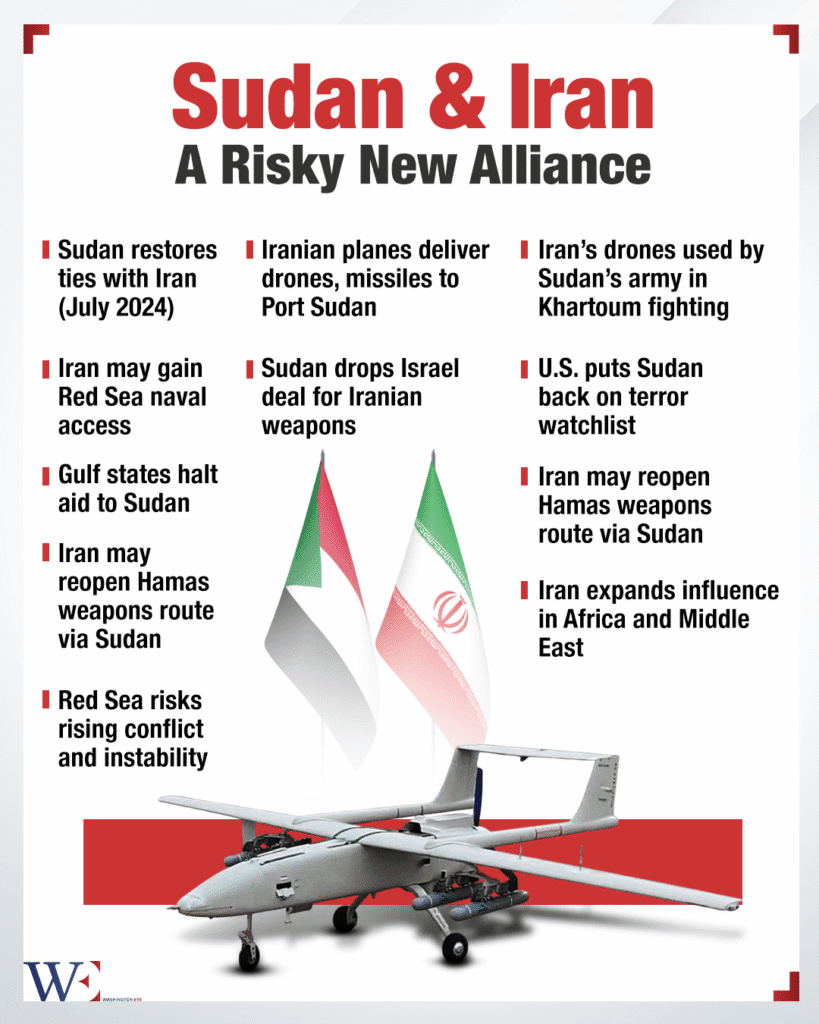In recent months, Sudan’s generals have quietly redrawn their foreign policy, moving steadily into Tehran’s orbit. In July 2024, Khartoum’s internationally recognized military government formally welcomed Iran’s ambassador—the first Sudanese envoy in Tehran since diplomatic ties were severed in 2016. Almost simultaneously, observers documented multiple Iranian arms shipments into Sudan. Conflict analysts tracked flights from Iran delivering Mohajer-6 reconnaissance drones and other munitions to Port Sudan, while journalists inspecting captured ordnance confirmed the army’s use of Iranian-made UAVs and missiles. What initially seemed like an isolated meeting has evolved into a deepening partnership. Experts warn that this rapid revival of ties—after years of estrangement—could reshape the balance of power in the Red Sea region.
Echoes of History: Religious Currents and Old Alliances
Sudan and Iran share more historical connections than geography alone might suggest—a fact well known to historians of the Mahdist era. When Muhammad Ahmad al-Mahdi and his followers carved out an independent state in Sudan (1885–1898), they drew on global Islamic networks. Scholars have noted that the swords and daggers of the Mahdist “Ansar” featured Persian-style designs, closely resembling Iranian Sufi weaponry of the era. While Qajar Persia never officially supported the Mahdi’s revolt against the Ottomans and British, the exchange of ideas—via Sufi brotherhoods and trade routes—left a cultural imprint. In that sense, Mahdist Sudan was already part of a broader Islamic world that included Persia.
Modern diplomatic ties began to take shape in the late 20th century. After the 1979 Iranian Revolution, Sudan’s Islamist military officers viewed Iran as a natural partner. In 1989, General Omar al-Bashir seized power and embarked on an ambitious effort to “Islamize” Sudan, welcoming Iranian support. Tehran reciprocated: it backed Bashir’s coup, providing arms, development aid, and military training. Iranian warships docked at Port Sudan, and Khartoum regularly aligned with Tehran in international forums—such as by affirming Iran’s right to pursue a nuclear program. By the early 2000s, Sudan had become Iran’s closest ally in Africa and its third-largest trading partner on the continent. For years, Sudan’s rhetoric echoed Tehran’s: opposing Israel, supporting Iran’s regional ambitions, and even deploying troops to fight in Iran’s proxy wars.
That alliance began to unravel in the 2010s as Gulf politics started to eclipse Iran’s influence. Facing economic crisis and growing isolation, Bashir’s government pivoted toward the GCC in search of financial support. In January 2016, after mobs attacked Saudi diplomatic missions in Tehran, Sudan abruptly severed ties with Iran—closing Tehran’s cultural centers in Khartoum and expelling Iranian diplomats. Bashir then turned to Riyadh and Abu Dhabi for aid, even deploying Sudanese troops to join the Saudi-led war in Yemen against Iran’s Houthi allies. By mid-2016, Sudan had fully aligned with the Sunni Arab bloc, effectively sidelining Tehran.
Broken Promises and New Deals
This Arab-Gulf realignment carried Sudan into the 2020s, culminating in its decision to join Morocco, the UAE, and Bahrain in the Abraham Accords. In October 2020, Sudan’s transitional civilian government, enticed by promises of funding and debt relief from the United States, agreed to normalize relations with Israel. Khartoum’s coalition government (a joint military-civilian leadership) signed on to the Abraham Accords framework, which promised financial support and stronger international ties in exchange for official recognition of Israel.
However, the deal quickly ran into domestic opposition. Hard-line Islamists in Sudan protested, and Hamas denounced the agreement, threatening its viability. Following Sudan’s 2021 military coup, regional concerns grew that the new regime would abandon the Sudan-Israel accord. By late 2023, as Sudan descended into civil war, the agreement had effectively collapsed.
Sudan extracted what it could from the GCC and the U.S., then pivoted to broker a new deal with Iran. In October 2023, just days after Hamas’s cross-border attacks on Israel, General Abdel Fattah al-Burhan announced a new “phase” in Khartoum–Tehran relations. In practice, this meant fully restoring diplomatic ties and military cooperation. Sudan’s foreign ministry described it as “the beginning of a new phase” when it received Iran’s ambassador in Port Sudan—even as fighting engulfed Khartoum and government operations relocated to the embattled port city. Behind the scenes, Burhan’s generals sought Iranian assistance. With the West unwilling to support the military coup, Khartoum turned to Tehran. According to informed sources, Sudan’s military leaders effectively traded their recognition of Israel for Iranian arms, ending their brief participation in the Abraham Accords.
Sudan’s foreign minister, Ali al-Sadiq, quickly met with Iranian Foreign Minister Hossein Amirabdollahian in Tehran (February 2024), marking a dramatic thaw between the new military regime and Iran. Since then, Iran has quietly funneled weaponry into Sudan. Satellite imagery and observer reports (documented by The Washington Post) recorded at least seven Iranian military flights to Sudan between late 2023 and mid-2024. Iranian Mohajer-6 drones have flown over Omdurman, targeting rebel positions and reportedly helping Sudan’s army regain parts of the capital. The African Defense Forum also notes that Iran has provided intelligence training and has begun recruiting and arming new units in Sudan, particularly from refugee camps, to bolster Burhan’s forces. Iranian drones and missiles have become so essential that Sudan’s generals now depend on them as a critical enabler of battlefield success.
Hamas, Hezbollah, and the Axis of Resistance
Iran’s renewed influence in Sudan cannot be separated from the wider Middle East conflict, particularly the Gaza war and Tehran’s proxy strategy. Iran has long bankrolled Hamas, Hezbollah, and the Houthis, with Western estimates placing its annual support to Hamas alone in the tens of millions of dollars. Hamas leaders previously operated openly from Khartoum, and Sudanese officials in the 2000s often spoke of channeling aid to Gaza via the Sinai. Israel has accused Sudan of serving as a transit point for Iranian rockets bound for Gaza—a charge Sudan denied at the time.
Today, many fear a repeat of that history. Sudan’s new rulers and Iran share a common Islamist platform. An Israeli security think tank recently warned: “Sudan historically served as a crucial transit point for Iranian weapons destined for Hamas in Gaza via Egypt.” If Khartoum is now aligned with Tehran, that arms pipeline could re-open. Already, Sudanese Islamist politicians have publicly vowed to support Palestinian resistance; one senior official declared that Sudan’s government “will not stop supporting Hamas” despite the Gaza conflict. With Iran’s backing, Khartoum’s generals could allow Iranian arms to transit through Egypt’s Sinai or even covertly supply Palestinian militants themselves.
Israel and its Arab partners view Sudan’s shift as a threat to regional peace efforts. U.S. and Israeli officials have warned that Burhan’s move may irrevocably damage the Sudan-Israel deal. One Israeli commentator bluntly stated that Sudan’s army chief “may be inclined to sever ties with the United States and Israel” if it ensures continued Iranian weapons supplies. In essence, a Sudan aligned with Tehran is likely to abandon its pro-Western posture and fully join Iran’s “axis of resistance”—alongside Hamas, Hezbollah, and the Houthis—in opposition to Israel, the GCC, and the U.S.
Red Sea Risks and Regional Implications
Why should the broader international community care about Sudan’s deepening ties with Tehran? The answer lies in geography and global trade. Sudan’s 360-mile Red Sea coastline borders one of the world’s busiest maritime corridors. Analysts warn that an Iranian foothold there could enable Tehran to threaten the vital Suez shipping route and strengthen its allies in Yemen. In March 2024, a Wall Street Journal report claimed Iran offered Sudan advanced weapons in exchange for permission to establish a naval base on its Red Sea coast—an offer Khartoum officially denied. Even without a formal base, Iran’s drones over Sudan and its Houthi allies in neighboring Yemen create a growing choke point for international trade. As one Middle East security expert noted, Iranian arms in Sudan “will further ignite conflicts there and in surrounding countries” and “turn the Red Sea into a theater for international confrontation.”
Sudan’s renewed intimacy with Iran is both a geopolitical warning to the region and a high-stakes gamble for Khartoum. For Iran, it represents a breakthrough—a potential land bridge to the Red Sea. For Sudan, it is a calculated risk: while the weapons are welcome, they come with geopolitical strings. Riyadh and Abu Dhabi have already frozen aid and publicly warned of consequences. U.S. officials have reinstated Sudan on a terrorism watchlist, even as Sudanese generals insist they remain “committed to peace” and friendly toward neighboring states.
Sudan’s re-alignment also reflects Iran’s evolving strategy: expanding its proxy network into Africa. With Hezbollah weakened and Hamas under pressure, Iran appears eager to cultivate new proxies, and Africa offers fertile ground. Beyond Sudan, South Africa has emerged as a surprising ally, not only normalizing ties but also supporting Iran by filing a case against Netanyahu at the ICC. There is speculation that Iran helped the ANC settle its debts ahead of national elections, with former President Trump even accusing South Africa of collaborating with Iran on nuclear projects—charges he cited in an executive order cutting U.S. aid to the country.




















